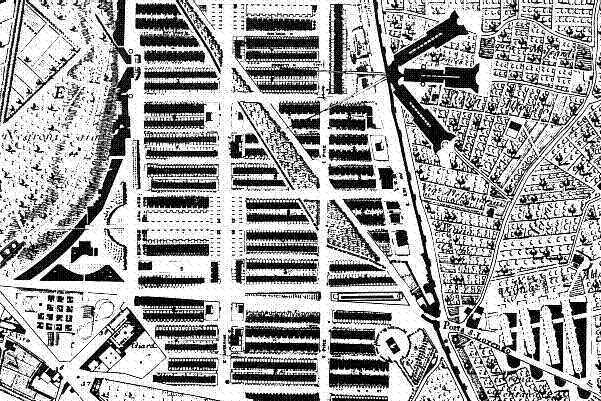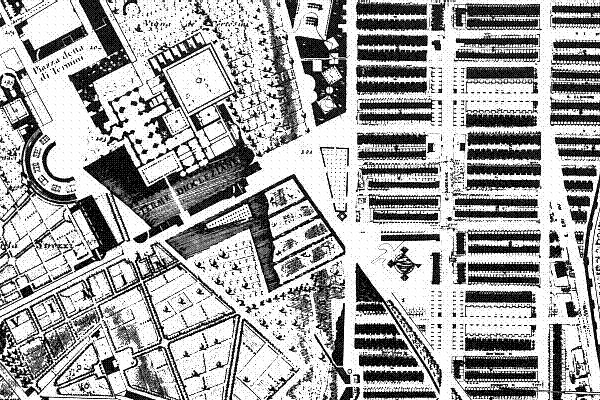| |
1997.01.29
More Exhibit Graphics: Inspiration XIII
Giurgola's Roma Interrotta: ...overlay of the Philadelphia plan. ...photograph Mitchell/Giurgola buildings that are spread throughout Center City.
...including all the Mitchell/Giurgola projects that were not built in Philadelphia into the Philadelphia CAD model. This concept also brings to mind the inclusion of other buildings that could be included: Kahn's City Hall, Kahn's planning study, and even a reconstructions of past Philadelphia like Furness buildings destroyed, and even the districts that were demolished to make way for Independence Mall and Penn Center.
1999.09.24
since equinoctial augury
The Philadelphia and Rome connections do not always have to be evident, but I'm sure that enough interesting notions will arise. There are already good connections, the Ara Martis-Independence Mall coincidence, the Fairmount-Campidoglio coincidence, dies sanguinis, the Hadrian tomb-Logan Circle coincidence, cardo and decumanus (and this can compare to Eros and Thanatos).
Overall, this project will hold together because I have the Center City model and the Campo Marzio database, and I also have all the Rome books and the Philadelphia guide books. I just also remembered the Roma Interrotta connection via Giurgola and VRSB, and then also the general Kahn and Venturi Campo Marzio connection.
| |
1997.03.20


Romaldo Giurgola, Roma Interrotta: Sector VI (1978).
Romaldo Giurgola has made a small city in the image of the upper west side of Manhattan [although the urban context employed is from a Sanbourne map of North Philadelphia] with all the amenities of Ebenezer Howard's garden city. With residences, offices, factories and recreation all within walking distance, and all appropriately 'greened', Giurgola's project is eminently believable and would probably be a very successful urban development. It is ironic that an expatriate Italian would export urban America back to Rome -- a curious reversal of the American preference for the importation of things European. But it is difficult to accept the ease of Giurgola's wholesale purchase of the gridiron of New York or Philadelphia as the ultimate urban paradigm without further question or speculation.
Alan Chimacoff, "Roma Interrotta Reviewed," Architectural Design, vol. 49, no. 3-4, 1979.
Using Nolli's Rome of 1748 as a start, Giurgola essentially created a "virtual" rendition of the surroundings that best suits his architectural ideals. It is an environment that harbors a deep respect for existing conditions, both natural and man-made. This is a paradigm that "works," largely because its architectural forms strive to demonstrate how things actually do work. It remains faithfully "virtual," however, because it is real and unreal at the same time.
seeking precedents... ...finding inspiration
| |
2006.02.02 12:46
Thesis Semester [blog] 25 years ago
Today, 2 February is the (new) feast of St. Catherine de Ricci. Catherine died 2 February 1590. My thesis project is seminally a reenactment of Louis Kahn's design of the Motherhouse of the Dominican Sisters of St. Catherine de Ricci. I knew nothing of St. Catherine de Ricci in 1981, but I know much more now...
My virtual thesis project for 2006 is entitled "Reenacting Roma Interrotta Sector VI". The design team of RI Sector VI was Romaldo Giurgola, Harold Guida, Sigrid Miller and Giancarlo Alhdeff. This project has everything to do with blending an 18th century sector of Rome with a 20th century sector of North Philadelphia.
2012.07.06 12:19
The Philadelphia School, deterritorialized
The Philadelphia School, deterritorialized will often investigate the (early) relationship between Giurgola architecture and Venturi architecture, as well as their respective relationships with Kahn architecture. One of the last episodes between Giurgola and Venturi occurred at the very beginnings of Roma Interrotta. When each of the invited architects received their section of the Nolli map of Rome, they also got to see what sections the other invited architects received. The Venturi office preferred the section received by the Giurgola office, so the Venturi office asked the Giurgola office if they wouldn't mind exchanging sections. The Giurgola office said they'd be happy to exchange, but they would rather ask the Roma Interrotta people before doing so. The Roma Interrotta people said the exchange was OK, and the rest is architectural history.
|